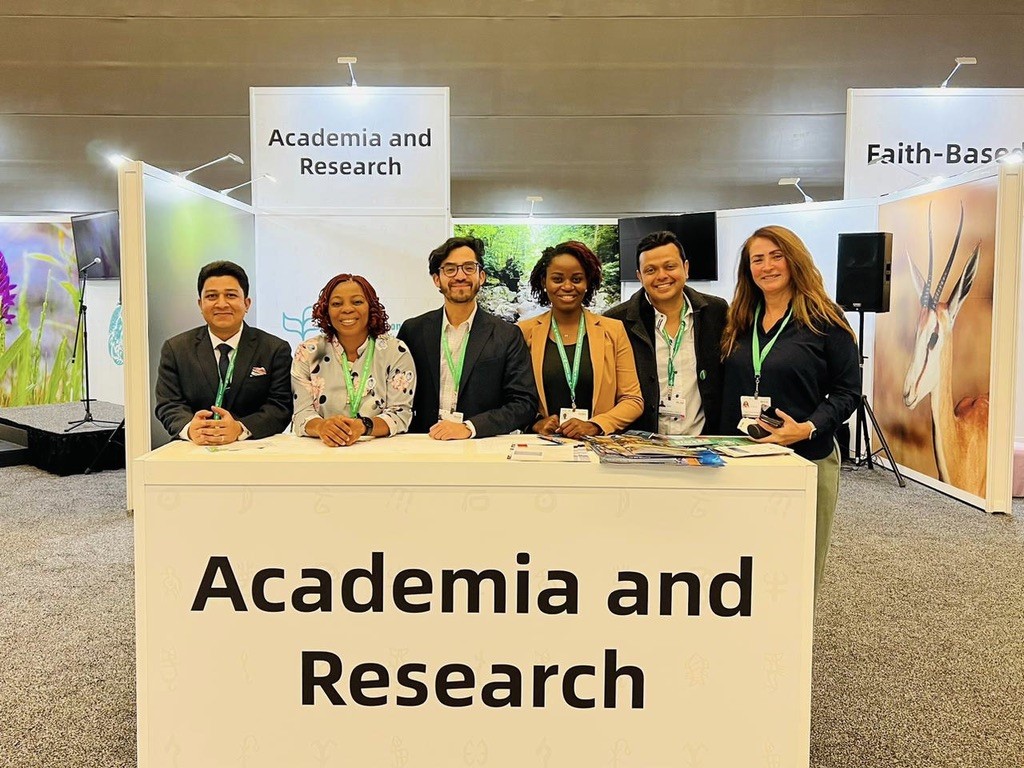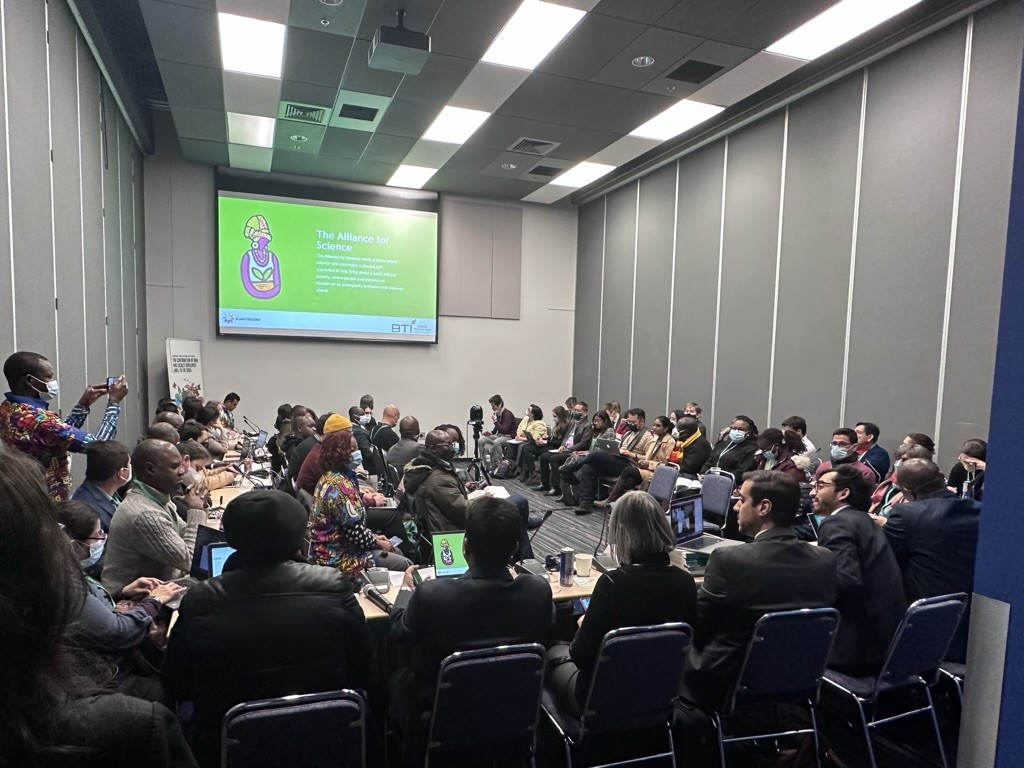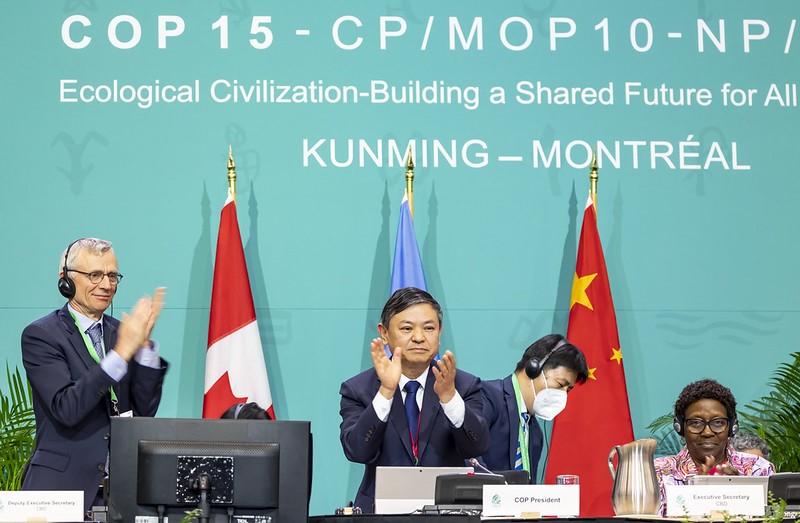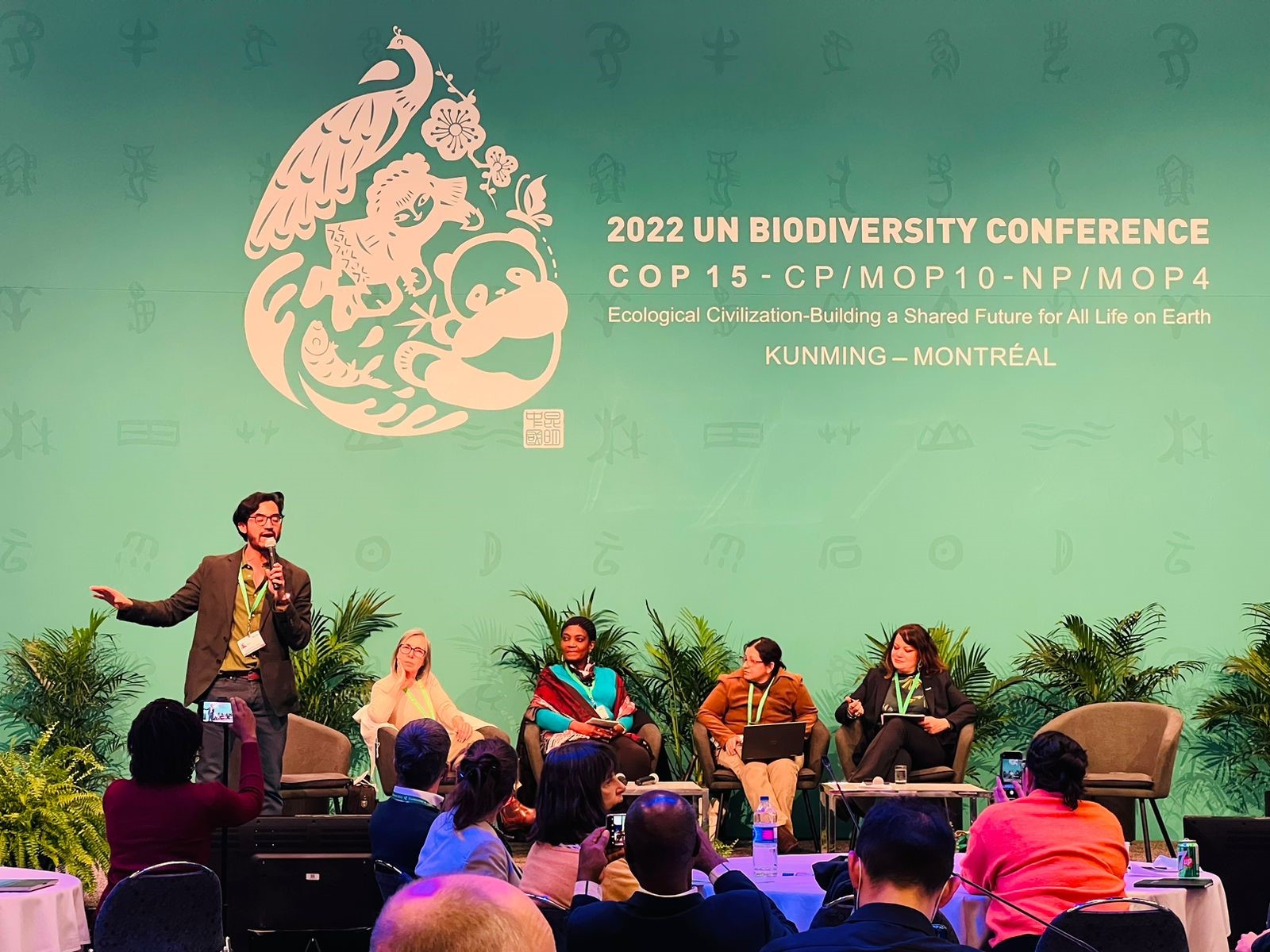Around 200 nations attended the 15th Conference of Parties to the UN Convention on Biological Diversity in Montreal at the end of December 2022.
The event boasted around 16,000 participants from governments, UN and international organizations, Indigenous Peoples and local communities (IPLCs), non-governmental organizations, academia, and the private sector.
The conference resulted in the adoption of a package of decisions aimed at halting the biodiversity crisis and changing our current trajectory of habitat loss and global warming.
The biggest success of the conference was the adoption of the “Kunming-Montreal Global Biodiversity Framework” -GBF-.
A framework that will be the roadmap for all countries to protect and restore nature, and use it sustainably with four clear goals and 23 targets for achievement by 2030.
The Alliance for Science (AfS) sent a delegation to Montreal to support the negotiations on the topic of biotechnology at COP15, because we seek a future where science and innovation are shared and supported to help achieve more sustainable practices to create an ecologically protected and restored planet.

Our mission-driven delegation hosted two side events[i] and advocated for science-based solutions with parties and observers during negotiations.
AfS also launched the Biodiversity Innovation Coalition[ii] along with ISAAA, PRRI, Igem, and Youth Biotech. Our pro-innovation group also actively supported an initiative to ensure better access to the CBD by academia and research groups.

The GBF is a landmark agreement. We must look back and asses what was negotiated, what this means for biotechnology, and what happens next.
How did the negotiations play out and what was agreed upon?
The negotiations were not easy. Progress stalled throughout the summit, as stark dissenting views among governments constantly slowed discussions.
Technical deliberations were not enough to advance agreements so ministerial and presidential interventions had to be set up to focus on the interlinked and outstanding political issues.
The final acceptance of the package of decisions (including the approval of the GBF) was discussed at dawn, on Monday, December 19.
At around 3am, with tensions and exhaustion running high, President Huang Runqiu called for final approval from all parties. As many voiced their acceptance, the Democratic Republic of Congo -DRC- sternly voiced concerns about the amount of funding allocated for the implementation of the many commitments included in the GBF.
The DRC’s reservation had been a major point of disagreement throughout the summit.
The disagreement which developed countries pushed for more ambitious goals and developing countries required the allocation of enough resources for implementation.
The disagreement had even prompted a “walk out” of developing countries mid-way through the negotiations.
Ultimately, the president proposed the adoption of the package by acclamation (applause) and history was made as the approval was reached by “consensus”.

The GBF is a hard-earned compromise. The language used may not be ambitious enough for some and many decisions leave a lot of space for national interpretation.
However, the outcome is workable and a big success considering the complexity of the issues and the limited time parties had to culminate the work.
The key global targets from the GBF agreement highlighted by the CBD Secretariat’s official press release include:
- Restore 30 percent of degraded ecosystems globally (on land and sea) by 2030.
- Conserve and manage 30 percent of areas (terrestrial, inland water, and coastal and marine) by 2030.
- Stop the extinction of known species, and by 2050 reduce tenfold the extinction risk and rate of all species (including unknown).
- Reduce risk from pesticides by at least 50 percent by 2030.
- Reduce nutrients lost to the environment by at least 50 percent by 2030.
- Reduce pollution risks and negative impacts of pollution from all sources by 2030 to levels that are not harmful to biodiversity and ecosystem functions.
- Reduce the global footprint of consumption by 2030, including through significantly reducing overconsumption and waste generation and halving food waste.
- Sustainably manage areas under agriculture, aquaculture, fisheries, and forestry and substantially increase agroecology and other biodiversity-friendly practices.
- Tackle climate change through nature-based solutions
- Reduce the rate of introduction and establishment of invasive alien species by at least 50 percent by 2030.
- Secure the safe, legal, and sustainable use and trade of wild species by 2030.
- Green up urban spaces.
To achieve all targets, national governments shall first, review and update their National biodiversity strategies to align with the GBF.
After this, all countries have the obligation of reporting progress toward the goals and targets through national biodiversity plans.
However, since its inception, it was clear that governments need the active involvement of all stakeholders for the GBF to be successfully implemented.
Its implementation will require the cooperation and collaboration of youth, women, academia, farmers, Indigenous peoples, local communities (IPLCs), industry, and others.
All of us, as stakeholders, can help by supporting and monitoring national initiatives, policies, and regulations that seek to implement the GBF at the country level.

What about Biotechnology?
Out of the 23 targets that the GBF covers, only target 17 of the GBF directly addresses biosafety and biotechnology.
The discussions around this target had been polarized since its inception and parties could not find common ground throughout the many open-ended working groups and intercessional meetings leading up to COP15.

At the event, the negotiations continued to reflect opposing positions by not just parties but regional country blocs.
Parties engaged in fierce debates on a) the scope of the target, which means what type of biotech techniques are included; and b) if the target should focus only on risks or if language should be added to recognize and encourage the positive impacts of biotechnology for the objectives of the Convention and/or the contribution to the SDGs.
In regards to the target’s scope, the debate centered on determining what type of biotech techniques should be included.
The EU strongly advocated for the target to broadly consider all biotech applications and even include references to specific techniques such as gene editing and synthetic biology.
Belarus, Mexico, Egypt, and a couple more countries supported the EU’s position.
The opposing view considered that the target should only focus on LMOs resulting from biotechnology for a simple, clear, and operational scope.
The Africa Union working together as a block supported the reduced scope, highlighting how this would align with the Convention and the Protocols.
Other countries echoed this alignment approach such as New Zealand, Canada, and various Latin American countries.

The second issue that was highly contested was defining if the target should address both the risks and benefits of biotechnology.
The EU was by far the biggest advocate for focusing only on risks along with Mexico and Belarus.
Argentina, Brazil, Paraguay, and other Central American countries such as Guatemala advocated sternly for recognizing and encouraging the positive impacts of biotechnology for the objectives of the Convention and/or the contribution to the SDGs.
The Africa Union, the UK, and New Zealand along with others also supported the inclusion of benefits.
In the `end, the dispute was resolved by taking refuge in the neutral and balanced text of the convention.
The only agreement possible was to use text that directly referenced articles 8 (g) and 19 of the convention and use their exact wording. As many countries acknowledged, article 8 (g) of the CBD focuses on risks resulting from living modified organisms produced by modern biotech and article 19 on the benefits.
So too the countries agreed that the first part of the target would address risks and then the second part focus on the benefits.
AfS co-hosted a side event with Argentina, Kenya, Brazil, and Nigeria that displayed how locally developed LMOs produced through biotechnology can help us achieve the SDGs.
The final text of target 17 reads: “Establish, strengthen capacity for, and implement in all countries, biosafety measures as set out in Article 8(g) of the Convention on Biological Diversity and measures for the handling of biotechnology and distribution of its benefits as set out in Article 19 of the Convention.”
Even if the GBF is not legally binding, all countries agreed to plan, report on, review and voluntarily escalate efforts to accomplish target 17 (and all other targets).
For target 17 this means countries must prioritize setting up biosafety systems to regulate, manage or control the possible risks associated with the use and release of living-modified organisms.
As most countries already have a biosafety system in place, they can ramp up efforts to build up their capacity and improve its implementation so that they are functional, prioritize certainty, flexibility, and transparency to minimize risk and maximize the benefits of biotech products.
The target also refers to measures for handling biotechnology and the distribution of its benefits.
This means countries can increase measures that aim at encouraging their local scientists to collaborate with others and engage in biotech research for innovative solutions to biodiversity loss, climate change mitigation, and food security.
Countries should also not lose sight of how and who provides the genetic resources for biotech research and make sure that the resulting benefits are distributed fairly and equitably.

What are the pros and cons of target 17?
Countries can look to the GBF’s targets to establish national policies, regulations, guidelines, or recommendations.
Target 17 can help guide how a country handles these biotech innovations.
Overall, the target encourages positive changes but is limited in its possible benefit, we assess it as follows:
Pros:
- The target is balanced, it doesn’t focus only on risks but mentions benefits. This means that, through the framework, individual countries will be encouraged to focus on both the risks and the benefits of biotechnology for the next ten years. Although the mention of benefits is limited, it helps present a balanced view on the debate around the risks and benefits of biotech products, such as GMOs. Moreover, the evenness of the language does not discourage countries from using their local talent, resources, and scientific ingenuity to invest in innovations that offer locally appropriate and sustainable solutions.
- The target ensures consistency. The target’s scope aligns with the Convention and does not go beyond its articles 8(g). This means that the biosafety measures that countries will implement under the framework should focus on the potential risks of products of biotechnology (such as GMOs) and not on the technology itself. By ensuring consistency with the CBD and its protocols, the target also reinforces the agreement’s considerations on how modern biotechnology has great potential for human well-being if developed and used with adequate safety measures for the environment and human health.
- The target recognizes the need for the fair and equitable distribution of benefits resulting from biotechnology: The target links its research efforts to article 19 of the CBD. This means countries will be encouraged to improve their measures that guarantee that the resulting benefits from biotech research are distributed fairly and equitably to communities from where the genetic resource for the research was obtained.
Cons:
- The target does not promote innovation for accelerated achievement of the SDGs.
Unfortunately, the target does not include language that recognizes the benefits and potential of biotechnology to help us achieve the SDGs.
Explicit recognition of the successes of biotech products (such as locally developed agricultural GMOs) that have effectively contributed to the achievement of the SDGs and the vast potential of biotechnology applications for sustainability were left out.
The omission is particularly disappointing since many Parties pushed for its inclusion, referencing the ample literature that highlights the successes and potential of the technology to contribute to the achievement of the 2030 Agenda for Sustainable Development.
An explicit recognition would help encourage the use, development, and transfer of biotechnologies to achieve sustainability in a timeframe that keeps pace with the biodiversity and climate crisis.
- The target is too technical and non-specific. The target almost completely lifts language from articles 8 g and 19 of the CBD. This limits target 17 to technical wording and makes it difficult to communicate it to non-experts. It requires expertise in the CBD and its protocols to understand what it seeks to achieve. It will be difficult to communicate with stakeholders and does not make it easy for countries to set up straightforward strategies and action plans, as well as for monitoring and reviewing progress.
What’s next for the success of target 17? Monitoring, advocating, mobilizing and supporting
The CBD and its protocols establish biosafety principles that effectively aim to maximize the benefits and minimize the risks of biotechnology.
Target 17 reinforces this consideration by requiring nations to establish, strengthen capacity for, and implement biosafety measures to keep this balance.
A Country’s balanced approach can create an innovation-enabling environment that encourages the safe use of biotechnology to achieve local solutions for biodiversity loss and climate change.
As stakeholders, we can monitor, advocate, mobilize, and support governments’ actions to make sure that the CBD and Target 17 are used as guidance to create and protect an ecosystem in which research and innovation lead to safe, science-based solutions.
To achieve this, the first thing we can do as stakeholders is be informed. What is the current state of biotech and biosafety in our countries?
What actions are needed to improve these so that local talent can achieve evidence-based, innovative solutions to improve sustainability and conservation of biodiversity?
And how can we get these solutions to the communities that need them the most?

Here is how target 17 can encourage activities that contribute to the three pillars of the innovation environment: research, policy, and community.
Research: Target 17 encourages nations to take “legislative, administrative or policy measures, as appropriate, to provide for the effective participation in biotechnological research activities” (art 19 CBD).
Each country will have different needs according to their stage of biotech research and development; human capital and technology infrastructure.
However, for the public sector initiatives, our experience indicates that countries should prioritize measures that a) create financial streams and resources that cover a biotech product’s full development cycle; b) build capacity in product development, product launch planning, and post-release product stewardship; and c) establish community engagement and communication at an early research stage.
Policy: Target 17 reinforces principles and concepts established by the Convention and its protocols for a Biosafety System (legal framework for biotech products) that balances the needs of trade, the potential benefits of biotechnology, and environmental protection.
A functional biosafety system is one that efficiently and effectively approves safe biotech products through a process that assures certainty, flexibility, and transparency.
To encourage this, the government can promote consistency and clarity in their regulatory framework for biotech; reinforce a risk proportionate criterion (“what is needed vs what is nice to know”); improve their public participation practices to promote trust among consumers and stakeholders; and strengthen institutional structures and coordination.
All of these will not only encourage new research and reinforce ongoing but can effectively help in streamlining safe biotech products that benefit society.
Community
Community engagement and communication are key for any technology to reach its beneficiaries.
The GBF’s section on communication highlights how enhancing communication, education, and awareness of biodiversity and the uptake of the GBF by all actors is essential to achieve its effective implementation.
More importantly, this section states the importance of “Raising awareness on the critical role of science, technology, and innovation to strengthen scientific and technical capacities to monitor biodiversity, address knowledge gaps and develop innovative solutions to improve the conservation and sustainable use of biodiversity.”
It is key that we all engage in knowledge-sharing and communication activities on how biotechnology tools can develop innovations that avoid farmland expansion and help communities address the effects of climate change.
However, community engagement and communications should go beyond just the benefits of biotech. It is important to engage communities in all stages of biotech product development.
The best approach is a communication strategy that covers from how biotech tools are used in the lab to their eventual delivery in the areas where they are needed the most.
AfS welcomes partners to continue carrying out: seeing is believing tours that showcase biotech tools in the lab and the benefits in contained field trials; science diplomacy workshops that share knowledge on the importance of the Cartagena Protocol’s biosafety principles and public participation processes; and science communication workshops and materials for scientists, farmers, journalists, and other stakeholders.
Conclusion and Closing
The GBF’s target on biotechnology is consistent with the CBD and its protocols.
It takes a balanced approach to the risks and benefits of biotech, reinforcing that access to and transfer of biotechnologies are essential to attaining the objectives of the Convention and its Protocols.
The language used allows member countries to look to this target for guidance in creating a supportive environment for biotech research and innovations that can address climate change, and biodiversity loss and help sustainability efforts.
The next steps are key for collective monitoring, advocating, and mobilizing to hold nations accountable for implementing not just the biotech target but all of the GBF in a transformative way to meet the steep global challenges.
